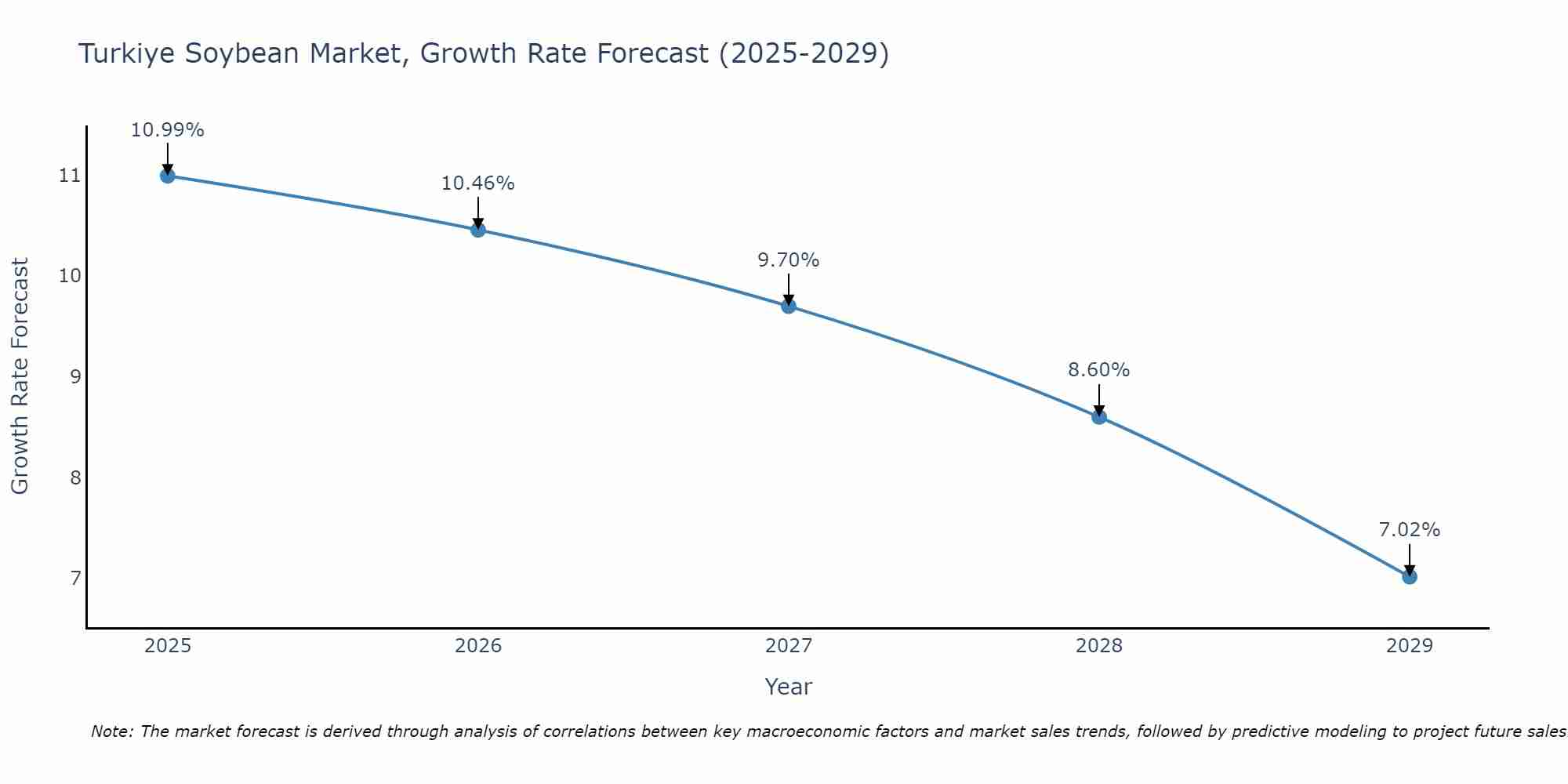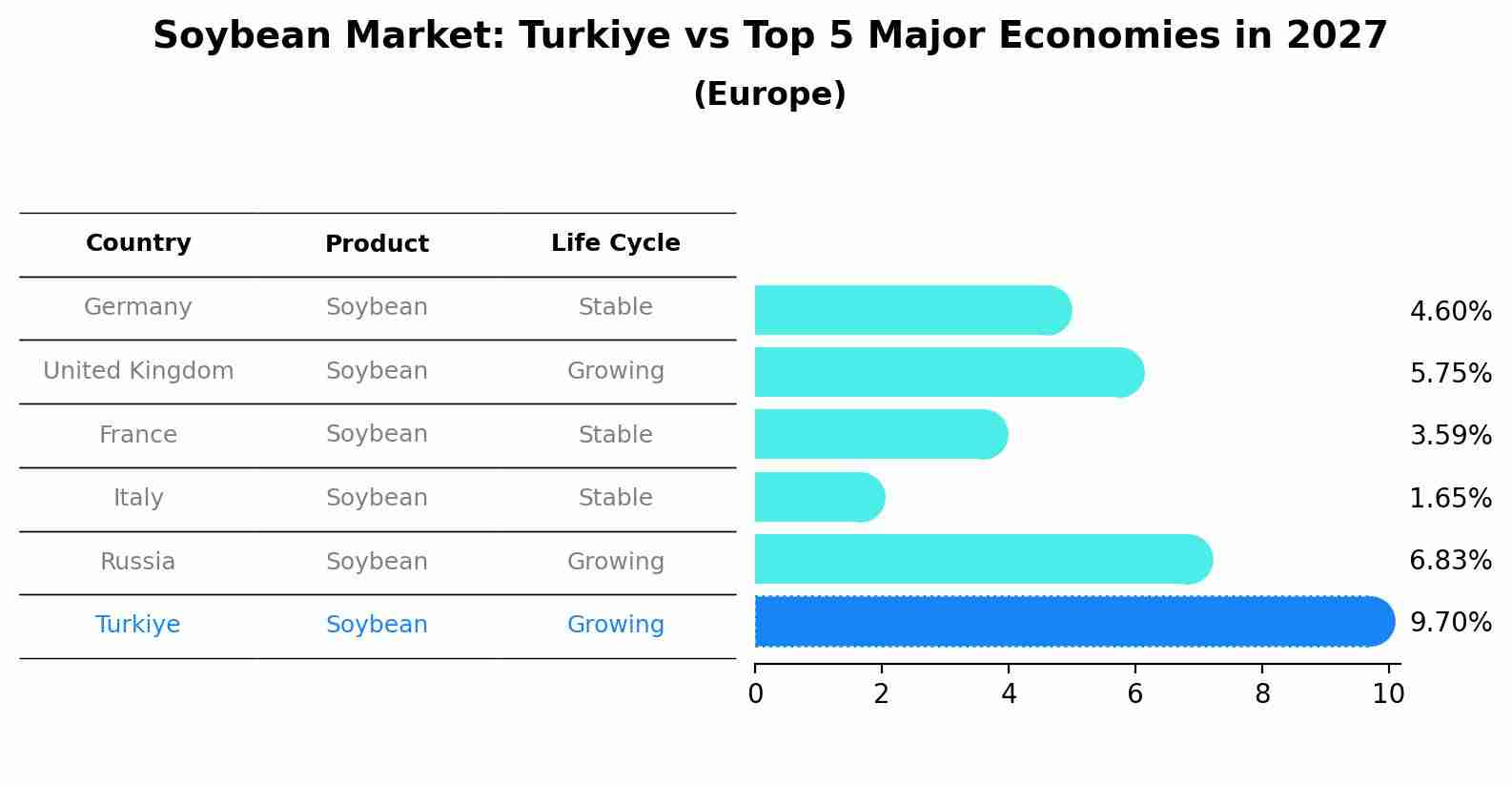Turkey Soybean Market Outlook | Size, Value, Forecast, Revenue, Analysis, COVID-19 IMPACT, Industry, Trends, Companies, Share & Growth
| Product Code: ETC224678 | Publication Date: Aug 2022 | Updated Date: Aug 2025 | Product Type: Market Research Report | |
| Publisher: 6Wresearch | Author: Dhaval Chaurasia | No. of Pages: 75 | No. of Figures: 35 | No. of Tables: 20 |
Turkiye Soybean Market Size Growth Rate
The Turkiye Soybean Market may undergo a gradual slowdown in growth rates between 2025 and 2029. Beginning strongly at 10.99% in 2025, growth softens to 7.02% in 2029.

Soybean Market: Turkiye vs Top 5 Major Economies in 2027 (Europe)
By 2027, the Soybean market in Turkiye is anticipated to reach a growth rate of 9.70%, as part of an increasingly competitive Europe region, where Germany remains at the forefront, supported by United Kingdom, France, Italy and Russia, driving innovations and market adoption across sectors.

Turkey Soybean Market Overview
The Turkey soybean market is steadily growing due to increasing demand for soybean products in various industries such as food, feed, and biofuels. Turkey heavily relies on soybean imports to meet its domestic demand, with the United States being a major supplier. The country`s growing poultry and livestock sectors are driving the demand for soybean meal for animal feed production. Additionally, the rising awareness of the health benefits associated with soy products is leading to an increase in consumer demand for soy-based foods. However, challenges such as fluctuations in global soybean prices, currency exchange rates, and trade policies can impact the market dynamics in Turkey. Overall, the Turkey soybean market is expected to continue its growth trajectory in the coming years with opportunities for both domestic and international suppliers.
Turkey Soybean Market Trends
The Turkey soybean market is experiencing a growing demand due to the increasing popularity of plant-based diets and the rising awareness of the health benefits associated with soy products. In recent years, there has been a shift towards the consumption of soy-based products such as soy milk, tofu, and meat alternatives. Additionally, the use of soybean oil in cooking and food processing has also seen a steady rise. The market is also influenced by the global soybean trade dynamics, with Turkey being a significant importer of soybeans for livestock feed and food processing purposes. As consumers become more health-conscious and environmentally aware, the trend towards plant-based protein sources like soybeans is expected to continue driving growth in the Turkey soybean market.
Turkey Soybean Market Challenges
In the Turkey Soybean Market, one of the key challenges faced is the heavy reliance on imports to meet domestic demand. This dependency on imported soybeans makes the market vulnerable to fluctuations in global prices, currency exchange rates, and trade policies. Additionally, lack of sufficient domestic production further exacerbates the issue, leading to concerns about food security and supply chain disruptions. Another challenge is the competition from other oilseed crops, such as sunflower and rapeseed, which limits the expansion of soybean cultivation in Turkey. Furthermore, regulatory barriers and limited government support for soybean farmers also hinder the growth of the market. Overall, addressing these challenges will be crucial in ensuring a stable and sustainable soybean market in Turkey.
Turkey Soybean Market Investment Opportunities
The Turkey soybean market presents promising investment opportunities due to the increasing demand for soybean products in various industries such as food, feed, and biofuel. Investors can consider investing in soybean cultivation, processing facilities, or trading companies to capitalize on the growing market. Additionally, there is potential for investment in research and development to improve soybean yields and quality in Turkey. With the country`s strategic location connecting Europe and Asia, investors can also explore opportunities for exporting soybean products to neighboring regions. Overall, the Turkey soybean market offers diverse investment avenues for those looking to participate in the expanding soybean industry and leverage the country`s agricultural potential.
Turkey Soybean Market Government Policy
The Turkish government has implemented various policies to support and regulate the soybean market within the country. These policies include subsidies for soybean production to boost domestic cultivation, import tariffs on soybean products to protect local farmers, and quality control standards to ensure the safety and integrity of soybean products in the market. Additionally, there are regulations in place to promote sustainable farming practices and environmentally-friendly production methods in the soybean sector. Overall, the government`s policies aim to strengthen the domestic soybean industry, reduce dependency on imports, and ensure a stable supply of high-quality soybean products for both domestic consumption and export markets.
Turkey Soybean Market Future Outlook
The future outlook for the Turkey Soybean Market appears optimistic with steady growth projected in the coming years. Increasing consumer awareness about the health benefits of soy products, rising demand for plant-based protein sources, and expanding applications in various industries such as food, feed, and pharmaceuticals are expected to drive market growth. Additionally, favorable government policies supporting soybean cultivation and processing, along with advancements in agricultural technology, are likely to enhance productivity and efficiency in the sector. However, challenges such as fluctuating global prices, environmental concerns related to soybean cultivation, and potential competition from alternative protein sources could impact market dynamics. Overall, the Turkey Soybean Market is poised for expansion, offering opportunities for both domestic producers and international traders.
Key Highlights of the Report:
- Turkey Soybean Market Outlook
- Market Size of Turkey Soybean Market, 2021
- Forecast of Turkey Soybean Market, 2031
- Historical Data and Forecast of Turkey Soybean Revenues & Volume for the Period 2018 - 2031
- Turkey Soybean Market Trend Evolution
- Turkey Soybean Market Drivers and Challenges
- Turkey Soybean Price Trends
- Turkey Soybean Porter's Five Forces
- Turkey Soybean Industry Life Cycle
- Historical Data and Forecast of Turkey Soybean Market Revenues & Volume By Applications for the Period 2018 - 2031
- Historical Data and Forecast of Turkey Soybean Market Revenues & Volume By Crush for the Period 2018 - 2031
- Historical Data and Forecast of Turkey Soybean Market Revenues & Volume By Feed Use for the Period 2018 - 2031
- Historical Data and Forecast of Turkey Soybean Market Revenues & Volume By Food Use for the Period 2018 - 2031
- Turkey Soybean Import Export Trade Statistics
- Market Opportunity Assessment By Applications
- Turkey Soybean Top Companies Market Share
- Turkey Soybean Competitive Benchmarking By Technical and Operational Parameters
- Turkey Soybean Company Profiles
- Turkey Soybean Key Strategic Recommendations
Frequently Asked Questions About the Market Study (FAQs):
1 Executive Summary |
2 Introduction |
2.1 Key Highlights of the Report |
2.2 Report Description |
2.3 Market Scope & Segmentation |
2.4 Research Methodology |
2.5 Assumptions |
3 Turkey Soybean Market Overview |
3.1 Turkey Country Macro Economic Indicators |
3.2 Turkey Soybean Market Revenues & Volume, 2021 & 2031F |
3.3 Turkey Soybean Market - Industry Life Cycle |
3.4 Turkey Soybean Market - Porter's Five Forces |
3.5 Turkey Soybean Market Revenues & Volume Share, By Applications, 2021 & 2031F |
4 Turkey Soybean Market Dynamics |
4.1 Impact Analysis |
4.2 Market Drivers |
4.2.1 Increasing consumer awareness about the health benefits of soybeans |
4.2.2 Growing demand for plant-based protein sources |
4.2.3 Government initiatives promoting soybean cultivation in Turkey |
4.3 Market Restraints |
4.3.1 Fluctuations in global soybean prices |
4.3.2 Weather conditions affecting soybean production |
4.3.3 Competition from other protein sources like lentils and chickpeas |
5 Turkey Soybean Market Trends |
6 Turkey Soybean Market, By Types |
6.1 Turkey Soybean Market, By Applications |
6.1.1 Overview and Analysis |
6.1.2 Turkey Soybean Market Revenues & Volume, By Applications, 2021-2031F |
6.1.3 Turkey Soybean Market Revenues & Volume, By Crush, 2021-2031F |
6.1.4 Turkey Soybean Market Revenues & Volume, By Feed Use, 2021-2031F |
6.1.5 Turkey Soybean Market Revenues & Volume, By Food Use, 2021-2031F |
7 Turkey Soybean Market Import-Export Trade Statistics |
7.1 Turkey Soybean Market Export to Major Countries |
7.2 Turkey Soybean Market Imports from Major Countries |
8 Turkey Soybean Market Key Performance Indicators |
8.1 Average yield per hectare of soybean crops in Turkey |
8.2 Percentage of agricultural land allocated to soybean cultivation |
8.3 Adoption rate of new soybean farming technologies in the market |
9 Turkey Soybean Market - Opportunity Assessment |
9.1 Turkey Soybean Market Opportunity Assessment, By Applications, 2021 & 2031F |
10 Turkey Soybean Market - Competitive Landscape |
10.1 Turkey Soybean Market Revenue Share, By Companies, 2021 |
10.2 Turkey Soybean Market Competitive Benchmarking, By Operating and Technical Parameters |
11 Company Profiles |
12 Recommendations |
13 Disclaimer |
- Single User License$ 1,995
- Department License$ 2,400
- Site License$ 3,120
- Global License$ 3,795
Search
Thought Leadership and Analyst Meet
Our Clients
Related Reports
- Afghanistan Apparel Market (2026-2032) | Growth, Outlook, Industry, Segmentation, Forecast, Size, Companies, Trends, Value, Share, Analysis & Revenue
- Canada Oil and Gas Market (2026-2032) | Share, Segmentation, Value, Industry, Trends, Forecast, Analysis, Size & Revenue, Growth, Competitive Landscape, Outlook, Companies
- Germany Breakfast Food Market (2026-2032) | Industry, Share, Growth, Size, Companies, Value, Analysis, Revenue, Trends, Forecast & Outlook
- Australia Briquette Market (2025-2031) | Growth, Size, Revenue, Forecast, Analysis, Trends, Value, Share, Industry & Companies
- Vietnam System Integrator Market (2025-2031) | Size, Companies, Analysis, Industry, Value, Forecast, Growth, Trends, Revenue & Share
- ASEAN and Thailand Brain Health Supplements Market (2025-2031) | Strategy, Consumer Insights, Analysis, Investment Trends, Opportunities, Growth, Size, Share, Industry, Revenue, Segments, Value, Segmentation, Supply, Forecast, Restraints, Outlook, Competition, Drivers, Trends, Demand, Pricing Analysis, Competitive, Strategic Insights, Companies, Challenges
- ASEAN Bearings Market (2025-2031) | Strategy, Consumer Insights, Analysis, Investment Trends, Opportunities, Growth, Size, Share, Industry, Revenue, Segments, Value, Segmentation, Supply, Forecast, Restraints, Outlook, Competition, Drivers, Trends, Demand, Pricing Analysis, Competitive, Strategic Insights, Companies, Challenges
- Europe Flooring Market (2025-2031) | Outlook, Share, Industry, Trends, Forecast, Companies, Revenue, Size, Analysis, Growth & Value
- Saudi Arabia Manlift Market (2025-2031) | Outlook, Size, Growth, Trends, Companies, Industry, Revenue, Value, Share, Forecast & Analysis
- Uganda Excavator, Crane, and Wheel Loaders Market (2025-2031) | Strategy, Consumer Insights, Analysis, Investment Trends, Opportunities, Growth, Size, Share, Industry, Revenue, Segments, Value, Segmentation, Supply, Forecast, Restraints, Outlook, Competition, Drivers, Trends, Demand, Pricing Analysis, Competitive, Strategic Insights, Companies, Challenges
Industry Events and Analyst Meet
Whitepaper
- Middle East & Africa Commercial Security Market Click here to view more.
- Middle East & Africa Fire Safety Systems & Equipment Market Click here to view more.
- GCC Drone Market Click here to view more.
- Middle East Lighting Fixture Market Click here to view more.
- GCC Physical & Perimeter Security Market Click here to view more.
6WResearch In News
- Doha a strategic location for EV manufacturing hub: IPA Qatar
- Demand for luxury TVs surging in the GCC, says Samsung
- Empowering Growth: The Thriving Journey of Bangladesh’s Cable Industry
- Demand for luxury TVs surging in the GCC, says Samsung
- Video call with a traditional healer? Once unthinkable, it’s now common in South Africa
- Intelligent Buildings To Smooth GCC’s Path To Net Zero


















